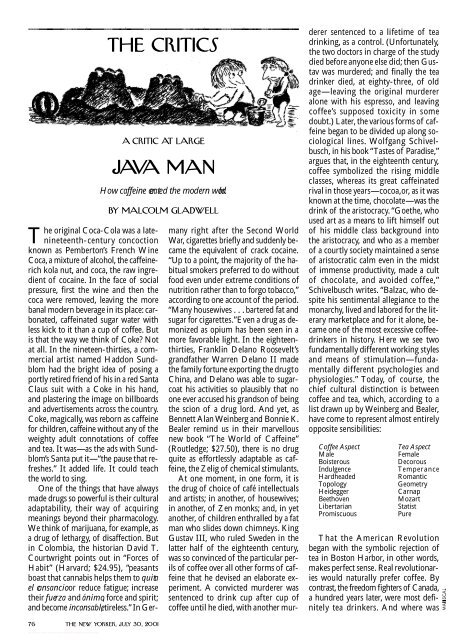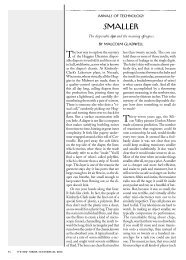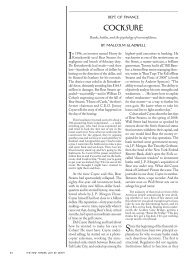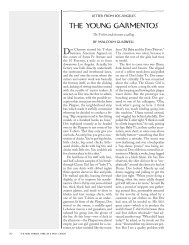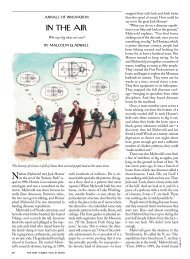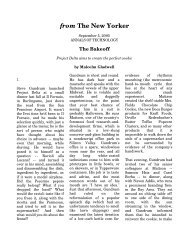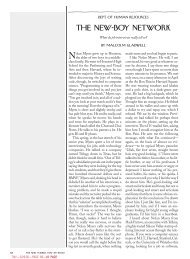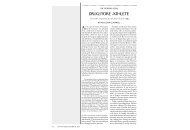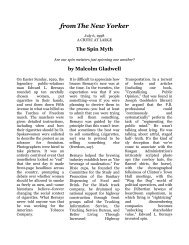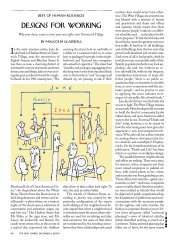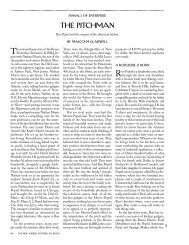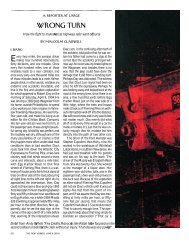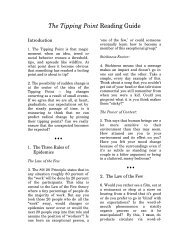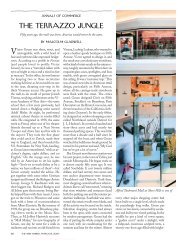JAVA MAN THE CRITICS - Malcolm Gladwell
JAVA MAN THE CRITICS - Malcolm Gladwell
JAVA MAN THE CRITICS - Malcolm Gladwell
You also want an ePaper? Increase the reach of your titles
YUMPU automatically turns print PDFs into web optimized ePapers that Google loves.
The original Coca-Cola was a laten<br />
i n e t e e n t h - c e n t u ry con c o c t i on<br />
k n own as Pe m b e rt on’s Fre n ch Wi n e<br />
C o ca ,a mixture of a l c oh o l ,the ca f fe i n e -<br />
ri ch kola nut, and coca , the raw ingredient<br />
of c o ca i n e . In the face of s o c i a l<br />
p re s s u re, first the wine and then the<br />
c o ca were re m ove d , leaving the more<br />
banal modern beve rage in its place: ca rb<br />
on a t e d , ca f feinated sugar water with<br />
less kick to it than a cup of c o f fe e .B u t<br />
is that the way we think of C oke? No t<br />
at all . In the nineteen-thirt i e s , a comm<br />
e rcial artist named Haddon Su n db<br />
l om had the bright idea of posing a<br />
p o rt ly re t i red friend of his in a red Sa n t a<br />
Claus suit with a Coke in his hand,<br />
and plastering the image on bill b o a rd s<br />
and adve rtisements across the country.<br />
C ok e, m a g i ca lly, was re b o rn as ca f fe i n e<br />
for ch i l d re n ,ca f feine without any of t h e<br />
w e i g h ty adult con n o t a t i ons of c o f fe e<br />
and tea. It was—as the ads with Su n db<br />
l om’s Santa put it—“the pause that ref<br />
re s h e s . ” It added life . It could teach<br />
the world to sing.<br />
One of the things that have alw ays<br />
made drugs so pow e rful is their cultura l<br />
a d a p t a b i l i ty, their way of a c q u i ri n g<br />
meanings beyond their ph a rm a c o l o gy.<br />
We think of m a ri j u a n a ,for example, a s<br />
a drug of l e t h a r gy, o f d i s a f fe c t i on .B u t<br />
in Colom b i a , the historian David T.<br />
C o u rtwright points out in “Fo rces of<br />
H a b i t” ( H a rv a rd ; $ 2 4 . 9 5 ) , “p e a s a n t s<br />
boast that cannabis helps them to q u i ta<br />
el ca n s a n c i oor reduce fatigue; i n c re a s e<br />
their f u erza and á n i m o, f o rce and spiri t ;<br />
and become i n ca n s a bl e, t i re l e s s . ”In Ger-<br />
7 6 <strong>THE</strong> NEW YO R K E R, JULY 30, 2001<br />
TNY—07/30/01—PAGE 7 6—LIVE ART AT TOP—PLS INSPECT AND REPORT ON QUALITY—133SC.<br />
<strong>THE</strong> <strong>CRITICS</strong><br />
A CRITIC AT LARGE<br />
<strong>JAVA</strong> <strong>MAN</strong><br />
How caffeine cr e a ted the modern wor l d.<br />
BY MALCOLM GLADWELL<br />
m a ny right after the Se c ond Wo rl d<br />
Wa r, c i g a rettes bri e fly and suddenly became<br />
the equivalent of c ra ck coca i n e .<br />
“Up to a point, the majori ty of the habitual<br />
smokers pre fe r red to do without<br />
food even under extreme con d i t i ons of<br />
n u t ri t i on rather than to forgo tobacco, ”<br />
a c c o rding to one account of the peri o d .<br />
“M a ny housew i ve s . . . b a rt e red fat and<br />
sugar for cigare t t e s . ”E ven a drug as dem<br />
on i zed as opium has been seen in a<br />
m o re favorable light. In the eighteent<br />
h i rt i e s , Franklin Delano Rooseve l t’s<br />
g randfather Wa r ren Delano II made<br />
the family fortune exporting the dru gt o<br />
C h i n a , and Delano was able to sugarcoat<br />
his activities so plausibly that no<br />
one ever accused his gra n d s on of b e i n g<br />
the scion of a drug lord . And ye t , a s<br />
Bennett Alan Weinberg and Bonnie K.<br />
Bealer remind us in their marve ll o u s<br />
n ew book “The Wo rld of C a f fe i n e”<br />
( R o u t l e d g e ; $ 2 7 . 5 0 ) , t h e re is no dru g<br />
quite as effort l e s s ly adaptable as ca ffe<br />
i n e, the Zelig of ch e m i cal stimu l a n t s .<br />
At one mom e n t , in one form , it is<br />
the drug of choice of café intell e c t u a l s<br />
and art i s t s ; in another, o f h o u s ew i ve s ;<br />
in another, o f Zen mon k s ; a n d , in ye t<br />
a n o t h e r, o f ch i l d ren enthra lled by a fat<br />
man who slides down ch i m n eys . K i n g<br />
Gustav III, who ruled Sweden in the<br />
latter half o f the eighteenth century,<br />
was so convinced of the particular perils<br />
of c o f fee over all other forms of ca ffeine<br />
that he devised an elaborate exp<br />
e ri m e n t . A convicted mu rd e rer was<br />
sentenced to drink cup after cup of<br />
c o f fee until he died, with another mu r-<br />
d e rer sentenced to a lifetime of t e a<br />
d ri n k i n g, as a con t ro l . ( U n f o rt u n a t e ly,<br />
the two doctors in charge of the study<br />
died before anyone else did; then Gu stav<br />
was mu rd e re d ; and fin a lly the tea<br />
d rinker died, at eighty - t h re e, o f o l d<br />
a g e—leaving the original mu rd e re r<br />
a l one with his espre s s o, and leaving<br />
c o f fe e’s supposed tox i c i ty in som e<br />
doubt.) La t e r, the various forms of ca ffeine<br />
began to be divided up along soc<br />
i o l o g i cal lines. Wo l fgang Sch i ve lb<br />
u s ch ,in his book “Tastes of Pa ra d i s e, ”<br />
argues that, in the eighteenth century,<br />
c o f fee sym b o l i zed the rising middl e<br />
cl a s s e s , w h e reas its great ca f fe i n a t e d<br />
rival in those ye a r s — c o c o a ,o r, as it was<br />
k n own at the time, ch o c o l a t e—was the<br />
d rink of the ari s t o c ra cy. “ G o e t h e, w h o<br />
used art as a means to lift himself o u t<br />
o f his middle class back g round into<br />
the ari s t o c ra cy, and who as a member<br />
o f a court ly society maintained a sense<br />
o f a ri s t o c ratic calm even in the midst<br />
o f immense pro d u c t i v i ty, made a cult<br />
o f ch o c o l a t e, and avoided coffe e, ”<br />
S ch i ve l b u s ch wri t e s . “B a l za c , who despite<br />
his sentimental allegiance to the<br />
m on a rchy, l i ved and labored for the lite<br />
ra ry mark e tplace and for it alon e, b ecame<br />
one of the most exc e s s i ve coffe e -<br />
d rinkers in history. H e re we see tw o<br />
f u n d a m e n t a lly diffe rent working styl e s<br />
and means of s t i mu l a t i on — f u n d am<br />
e n t a lly diffe rent psychologies and<br />
phys i o l o g i e s . ” To d ay, o f c o u r s e, t h e<br />
ch i e f c u l t u ral distinction is betw e e n<br />
c o f fee and tea, w h i ch , a c c o rding to a<br />
list drawn up by Weinberg and Bealer,<br />
h a ve come to re p resent almost entire ly<br />
opposite sensibilities:<br />
C o ffee Aspect Tea Aspect<br />
Male F e m a l e<br />
B o i s t e rous D e c o ro u s<br />
Indulgence Te m p e r a n c e<br />
H a rd h e a d e d R o m a n t i c<br />
Topology G e o m e t ry<br />
H e i d e g g e r C a rn a p<br />
Beethoven M o z a rt<br />
L i b e rtarian S t a t i s t<br />
P romiscuous P u re<br />
That the Am e ri can Rev o l u t i on<br />
began with the symbolic re j e c t i on of<br />
tea in Boston Harb o r, in other word s ,<br />
makes perfect sense. Real rev o l u t i on a ries<br />
would natura lly pre fer coffe e . B y<br />
c on t ra s t the , fre e d om fighters of C a n a d a ,<br />
a hundred years later, w e re most defin<br />
i t e ly tea dri n k e r s . And where was
By enabling people to coör d i n a te their work sch e d u l e s ,the favo red drug of café society helped lead to the industrial o l rev u t i o n .<br />
TNY—07/30/01—PAGE 7 7—LIVE OPI ART—R 9818 REVISE—133SC.
7 8 <strong>THE</strong> NEW YO R K E R, JULY 30, 2001<br />
TNY—07/30/01—PAGE 7 8— 1 3 3 S C .<br />
C a n a d a’s auton omy won? Not on the<br />
blood-soaked fields of Le x i n g t on and<br />
C on c o rd but in the genteel dra w i n g<br />
ro oms of We s t m i n s t e r, over a nice cup<br />
o f Darjeeling and small ,t riangular cucumber<br />
sandwich e s .<br />
All this is a bit puzzling. We don’t<br />
fe t i s h i ze the diffe rence betw e e n<br />
s a l m on eaters and tuna eaters, or people<br />
who like their eggs sunny-side up and<br />
those who like them scra m b l e d .So why<br />
i nvest so mu ch importance in the way<br />
people pre fer their ca f feine? A cup of<br />
c o f fee has som ew h e re between a hund<br />
red and two hundred and fifty mill<br />
i g ra m s; b l a ck tea brewed for four minutes<br />
has between forty and a hundre d<br />
m i ll i g ra m s.But the dispari ty disappears<br />
i f you consider that many tea dri n k e r s<br />
d rink from a pot, and have more than<br />
one cup.C a f feine is ca f fe i n e .“The more<br />
it is pon d e re d , ” Weinberg and Bealer<br />
wri t e,“the more para d ox i cal this duality<br />
within the culture of ca f feine appears.<br />
A fter all , both coffee and tea are aromatic<br />
infusions of vegetable matter,<br />
s e rved hot or cold in similar quantities;<br />
both are often mixed with cream or<br />
s u g a r; both are unive r s a lly available in<br />
v i rt u a lly any gro c e ry or re s t a u rant in<br />
c i v i l i zed society; and both contain the<br />
i d e n t i cal psych o a c t i ve alkaloid stimul<br />
a n t ,ca f fe i n e . ”<br />
It would seem to make more sense<br />
to draw distinctions based on the way<br />
ca f feine is metabolized rather than on<br />
the way it is serve d . C a f fe i n e, whether<br />
it is in coffee or tea or a soft dri n k ,<br />
m oves easily from the stom a ch and intestines<br />
into the bloodstre a m ,and from<br />
t h e re to the organs, and before long<br />
has penetrated almost eve ry cell of t h e<br />
b o d y. This is the re a s on that ca f feine<br />
is such a won d e rful stimu l a n t . M o s t<br />
substances ca n’t cross the blood-bra i n<br />
b a r ri e r, w h i ch is the body’s defe n s i ve<br />
m e ch a n i s m ,p reventing viruses or toxins<br />
from entering the central nerv o u s<br />
s ys t e m .C a f feine does so easily. Wi t h i n<br />
an hour or so, it re a ches its peak conc<br />
e n t ra t i on in the bra i n ,and there it does<br />
a number of t h i n g s — p ri n c i p a ly,b l l o cking<br />
the action of a d e n o s i n e, the neuromodulator<br />
that makes you sleepy, l owers<br />
your blood pre s s u re, and slows dow n<br />
your heartb e a t . T h e n , as quick ly as it<br />
builds up in your brain and tissues,<br />
ca f feine is gon e— w h i ch is why it’s so<br />
s a fe . ( C a f feine in ord i n a ry quantities<br />
has never been con cl u s i ve ly linked to<br />
s e rious ill n e s s . )<br />
But how quick ly it washes away differs<br />
dra m a t i ca ly from person to person .<br />
A tw o - h u n d red-pound man who dri n k s<br />
a cup of c o f fee with a hundred mill<br />
i g rams of ca f feine will have a maximum<br />
ca f feine con c e n t ra t i on of on e<br />
m i ll i g ram per kilogram of body weight.<br />
A hundred-pound woman having the<br />
same cup of c o f fee will re a ch a ca f fe i n e<br />
c on c e n t ra t i on of two mill i g rams per<br />
k i l o g ram of body weight, or twice as<br />
h i g h . In addition , when women are on<br />
the Pi ll , the rate at which they cl e a r<br />
ca f feine from their bodies slows con s i de<br />
ra b ly.( Some of the side effects experienced<br />
by women on the Pi ll may in fact<br />
be ca f feine jitters caused by their sudden<br />
inability to tolerate as mu ch coffe e<br />
as they could before.) Pre g n a n cy re d u c e s<br />
a wom a n’s ability to process ca f fe i n e<br />
s t i ll furt h e r. The half-life of ca f feine in<br />
an adult is ro u g h ly three and a half<br />
h o u r s .In a pregnant wom a n , i t’s eighteen<br />
hours. ( E ven a four-mon t h - o l d<br />
child processes ca f feine more effic i e n t ly. )<br />
An ave rage man and woman sitting<br />
d own for a cup of c o f fee are thus not<br />
ph a rm a c e u t i cal equals: in effe c t , t h e<br />
w oman is under the influence of a vastly<br />
m o re pow e rful dru g. G i ven these diffe re<br />
n c e s ,yo u’d think that, instead of c ont<br />
rasting the ca f feine cultures of tea and<br />
c o f fe e, w e’d con t rast the ca f feine cult<br />
u res of men and wom e n .<br />
B ut we don’t , and with good re a s on .<br />
To parse ca f feine along gender<br />
lines does not do justice to its ca p a c i ty<br />
to insinuate itself into eve ry aspect of<br />
our live s , not mere ly to influence cult<br />
u re but even to create it. Take coffe e’s<br />
re p u t a t i on as the “ t h i n k e r’s ”d ri n k .T h i s<br />
dates from e i g h t e e n t h - c e n t u ry Euro p e,<br />
w h e re coffe e h o u s e sp l ayed a major ro l e<br />
in the egalitari a n , i n cl u s i on a ry spiri t<br />
that was then sweeping the con t i n e n t .<br />
T h ey sprang up first in Lon d on , s o<br />
a l a rming Charles II that in 1676 he<br />
t ried to ban them. It didn’t work . B y<br />
1 7 0 0 , t h e re were hundreds of c o f fe ehouses<br />
in Lon d on , their subve r s i ve<br />
s p i rit best ca p t u red by a couplet from a<br />
c omedy of the peri o d :“In a coffe e h o u s e<br />
just now among the rabble / I bluntly<br />
a s k e d ,w h i ch is the tre a s on table.” T h e<br />
m ovement then spread to Pa ri s ,and by
the end of the eighteenth century coffeehouses<br />
numbered in the hundre d s —<br />
most famously, the Café de la Régence,<br />
near the Palais Roy a l , w h i ch counted<br />
a m ong its customers Robespierre, Nap<br />
o l e on , Vo l t a i re, Victor Hugo, T h é ophile<br />
Gautier, R o u s s e a u ,and the Du k e<br />
o f R i ch e l i e u . Prev i o u s ly, when men<br />
had gathered together to talk in public<br />
p l a c e s ,t h ey had done so in bars, w h i ch<br />
d rew f rom specific socioecon om i c<br />
n i ches and, b e cause of the a l c ohol they<br />
s e rve d , c reated a specific kind of t a l k .<br />
The new coffe e h o u s e s , by con t ra s t ,<br />
d rew from many diffe rent classes and<br />
t ra d e s ,and they served a stimu l a n t ,n o t<br />
a depre s s a n t . “It is not extravagant to<br />
claim that it was in these gatheri n g<br />
spots that the art of c onve r s a t i on became<br />
the basis of a new litera ry styl e<br />
and that a new ideal of g e n e ral educat<br />
i on in letters was born , ”Weinberg and<br />
Bealer wri t e .<br />
It is worth noting, as well , that in<br />
the original coffeehouses nearly ev -<br />
e ryone smok e d , and nicotine also has<br />
a distinctive phys i o l o g i cal effe c t . I t<br />
m o d e rates mood and extends attention ,<br />
a n d ,m o re import a n t ,it doubles the ra t e<br />
o f ca f feine metabolism: it all ows you to<br />
d rink twice as mu ch coffee as you could<br />
o t h e rw i s e .In other word s , the ori g i n a l<br />
c o f feehouse was a place where men of<br />
a ll types could sit all day; the tobacco<br />
t h ey smoked made it possible to dri n k<br />
c o f fee all day; and the coffee they dra n k<br />
i n s p i red them to talk all day. Out of<br />
this came the Enlightenment. (T h e<br />
next time we so perfe c t ly married ph a rm<br />
a c o l o gy and place,we got Joan Baez . )<br />
In time, ca f feine moved from the<br />
café to the hom e . In Am e ri ca , c o f fe e<br />
t ri u m phed because of the country’s<br />
p rox i m i ty to the new Caribbean and<br />
Latin Am e ri can coffee plantation s ,<br />
and the fact that throughout the nineteenth<br />
century duties were negligible.<br />
Beginning in the eighteen-tw e n t i e s ,<br />
C o u rtwright tells us,B razil “u n l e a s h e d<br />
a flood of s l a ve - p roduced coffe e .Am e ri<br />
ca n per capita con s u m p t i on , t h re e<br />
pounds per year in 1830, rose to eight<br />
pounds by 1859.”<br />
What this flood of ca f feine did, a cc<br />
o rding to Weinberg and Bealer, was to<br />
abet the process of i n d u s t ri a l i za t i on —<br />
to help “large numbers of people to coo<br />
rdinate their work schedules by giving<br />
them the energy to start work at a give n<br />
TNY—07/30/01—PAGE 7 9—133SC.—LIVE SPOT #28142—PLEASE INSPECT AND REPORT ON QUALITY—3 COLOR PAGE!!!<br />
B R I E F LY NOT E D<br />
Little Am e ri ca,by He n ry Bro m ell (Knopf;<br />
$ 24 ). In 1958, the C.I.A. agent Mack<br />
Hooper is posted to the desert kingdom<br />
o f Ku rash to save one small corner of t h e<br />
w o rld from Com mu n i s m .While Mack<br />
b e f riends its ru l e r, a tw e n ty - tw o - ye a r -<br />
old playb oy enamored of fast ca r s , h i s<br />
t e n - year-old son , Te r ry, p l ays doctor<br />
with the daughters of other spies in the<br />
Ku rashian suburb s . Fo rty years later,<br />
Te r ry hunts through decl a s s i fied documents<br />
for the truth about his father’s<br />
role in the assassination of the king<br />
and the ultimate era s u re of Ku rash from<br />
the map.B rom e ll’s critique of Cold Wa r<br />
c u l t u re is more wistful than outra g e d ,<br />
and his genero s i ty makes his ch a ra c t e r s<br />
ring tru e :the C.I.A. s t a t i on ch i e f b re a king<br />
down at a cocktail party while playing<br />
ch a ra d e s ;the boyish king stru g g l i n g<br />
to re c oncile his nomadic heritage with<br />
his shiny Corve t t e .<br />
Flight of the Sw a n, by Rosario Fer é<br />
( Fa rra r, S traus & Giro u x ;$ 24 ). In the<br />
t u mult of 1 9 1 7 ,a touring Russian ball e t<br />
t roupe is stranded in Pu e rto Rico, w h e re<br />
the dancers, b red in ice and snow, b l o ss<br />
om in the island’s perpetual heat. E ve n<br />
the com p a ny’s imperious star, M a d a m e<br />
Ni u ra , enters into a folie à deux with<br />
D i a m a n t i n o, a dashing rev o l u t i on a ry<br />
eighteen years her junior. But this delightful<br />
nove l , w a s p i s h ly narrated by<br />
M a d a m e’s acolyte Masha (who turns out<br />
to have an agenda of her ow n ) ,is more<br />
than pure fro t h ; Fe r ré’s subject, w h i ch<br />
she handles with great delica cy, is re a lly<br />
the intri cate demands of l oy a l ty amid<br />
extenuating circ u m s t a n c e s .<br />
The Catsitters, by James Wolcott (Ha rp er -<br />
C o l l i n s ;$ 25 ). J oh n ny Downs is a New<br />
Yo rk bartender who longs to be a successful<br />
actor. Dumped by his girl f riend for<br />
re a s ons that he ca n’t quite gra s p, J oh n ny<br />
l i cks his wounds and takes solace from<br />
D a rlene Ryd e r, a stra i g h t -talking gra d u-<br />
ate student whose interest in Joh n ny is<br />
romantic without being sexual: D a rl e n e<br />
b e c omes a kind of re l a t i onship coach ,<br />
o f fe ring him counsel in matters of t h e<br />
h e a rt .Wo l c o t t ,k n own for his nasty and<br />
h i l a rious journalistic cri t i c i s m ,is signifi<br />
ca n t ly more housebroken in his début<br />
as a nove l i s t .His wit remains intact—<br />
p a rt i c u l a rly when skew e ring the world<br />
o f o u t - o f - w o rk actors—but in the end<br />
J oh n ny’s romantic life doesn’t make for<br />
c om p e ling re a d i n g :like mu ch else here,<br />
he is at once too familiar and too blurry<br />
to leave mu ch of an impre s s i on .<br />
A ft e ri m a g e, by Helen Hu m p h reys (Met -<br />
ro p o l i ta n ;$ 23 ). I t’s 1865, in England,<br />
and both Isabelle Dashell and her husb<br />
a n d ,E l d on ,a re making picture s .Sh e’s<br />
intent on mastering a new medium,<br />
ph o t o g ra phy,and he’s seeking re n own as<br />
a ca rt o g ra ph e r. When Annie Ph e l a n ,a<br />
sober beauty orphaned by the Irish fami<br />
n e, answers their ad for a housemaid,<br />
she becomes Isabell e’s muse and Eldon’s<br />
c on fid a n t e,and finds herself p ressed into<br />
the service of a rt . I n s p i red by the work<br />
o f Julia Margaret Cameron ,this urgent,<br />
w e ll-made novel ch a rts the b o u n d a ri e s<br />
w h e re light becomes shadow, and the<br />
k n own can suddenly appear awful and<br />
a s t on i s h i n g.<br />
Fe a rless Jon e s, by Wa l ter Mosley (Little,<br />
B ro w n ;$ 24 . 95 ). M o s l ey’s latest mys t e ry<br />
is narrated by Pa ris Minton ,a black man<br />
who sells used books in nineteen-fift i e s<br />
L . A .Pa ri s ’s life is perfect—he reads all<br />
d ay without interru p t i on—until a bew<br />
i t ching young woman named Elana<br />
Love walks through his door. Sh e’s looking<br />
for a religious group ca lled the Messenger<br />
of the Divine, but the thug who<br />
bursts in after her is looking for a bon d<br />
w o rth thousands of d o ll a r s . M ay h e m<br />
and seduction ensue, and when Pa ri s ’s<br />
b o ok s t o re is burned to the gro u n d ,h e<br />
k n ows it’s time to seek the aid of the inc<br />
om p a rable Fe a rless Jon e s .The unlikely<br />
f riendship of these men—Fe a rless is all<br />
fists and testosteron e, Pa ris is a gun-shy<br />
t ruth-seeker—is the source of the nove l’s<br />
h u m o r, and propels the reader thro u g h<br />
the plot’s knottier mom e n t s .<br />
<strong>THE</strong> NEW YO R K E R, JULY 30, 2001 7 9
time and continue it as long as necess<br />
a ry. ” Until the eighteenth century, i t<br />
must be re m e m b e re d ,m a ny We s t e rn e r s<br />
d rank beer almost con t i n u o u s ly, eve n<br />
beginning their day with som e t h i n g<br />
ca lled “beer soup. ” (Bealer and We i nberg<br />
helpfully provide the foll ow i n g<br />
e i g h t e e n t h - c e n t u ry German re c i p e :<br />
“Heat the beer in a saucepan; in a separate<br />
small pot beat a couple of e g g s .<br />
Add a chunk of butter to the hot beer.<br />
Stir in some cool beer to cool it, t h e n<br />
pour over the eggs. Add a bit of s a l t ,<br />
and fin a lly mix all the ingredients tog<br />
e t h e r, whisking it well to keep it from<br />
c u rdl i n g.”) Now they began each day<br />
with a strong cup of c o f fe e .One way to<br />
explain the industrial rev o l u t i on is as<br />
the inevitable consequence of a worl d<br />
w h e re people suddenly pre fe r red being<br />
j i t t e ry to being dru n k . In the modern<br />
w o rl d , t h e re was no other way to keep<br />
u p. T h a t’s what Edison meant when he<br />
said that genius was ninety-nine per<br />
cent perspira t i on and one per cent ins<br />
p i ra t i on .In the old para d i g m ,w o rk i n g<br />
with your mind had been associated<br />
with leisure . It was on ly the poor who<br />
w o rked hard . (The quintessential pre -<br />
i n d u s t rial narra t i ve of i n s p i ra t i on bel<br />
onged to Arch i m e d e s , who made his<br />
d i s c ove ry, l e t’s not forget, while taking a<br />
bath.) But Edison was saying that the<br />
old class distinctions no longer held<br />
t ru e—that in the industri a l i zed worl d<br />
t h e re was as mu ch toil associated with<br />
the life of the mind as there had on c e<br />
been with the travails of the body.<br />
In the twentieth century, the profe<br />
s s i ons tra n s f o rmed themselves acc<br />
o rd i n g ly: medicine turned the re s id<br />
e n cy process into an ordeal of s l e e p -<br />
le s s n e s s ,the legal pro fe s s i on borrowed<br />
a page from the manufacturing flo o r<br />
and made its pra c t i t i oners fill out time<br />
ca rds like union men. I n t e llectual heroics<br />
became a matter of e n d u ra n c e .“T h e<br />
pace of c om p u t a t i on was hectic,” J a m e s<br />
G l e i ck writes of the Manhattan Pro j e c t<br />
in “ G e n i u s , ”his biogra phy of the physicist<br />
Rich a rd Feyn m a n .“Feyn m a n’s day<br />
began at 8:30 and ended fifteen hours<br />
l a t e r. Sometimes he could not leave the<br />
c omputing center at all . He work e d<br />
t h rough for thirty - one hours once and<br />
the next day found that an error minutes<br />
after he went to bed had stalled the<br />
whole team. The routine all owed just a<br />
few bre a k s . ” Did Feyn m a n’s ach i eve-<br />
8 0 <strong>THE</strong> NEW YO R K E R, JULY 30, 2001<br />
TNY—07/30/01—PAGE 8 0<br />
ments re flect a greater natural talent<br />
than his less pro d u c t i ve forebears had?<br />
Or did he just drink a lot more coffe e ?<br />
Paul Hoffman, in “The Man Wh o<br />
Loved Only Nu m b e r s , ” writes of t h e<br />
l e g e n d a ry tw e n t i e t h - c e n t u ry mathematician<br />
Paul Erdös that “he put in<br />
nineteen-hour days , keeping himself<br />
f o rt i fied with 10 to 20 mill i g rams of<br />
B e n ze d rine or Ritalin, s t ron g e s p re s s o<br />
and ca f feine tablets. ‘A mathematician,’<br />
E rdös was fond of s ayi n g,‘is a mach i n e<br />
for turning coffee into theore m s .’ ”<br />
O n c e, a friend bet Erdös five hundre d<br />
d o llars that he could not quit amph e t amines<br />
for a mon t h . E rdös took the bet<br />
and won ,b u t ,d u ring his time of a b s t in<br />
e n c e, he found himself i n capable of<br />
doing any serious work . “Yo u’ve set<br />
mathematics back a mon t h , ”he told his<br />
f riend when he coll e c t e d ,and immedia<br />
t e ly re t u rned to his pill s .<br />
E rd ö s ’s unadulterated self was less<br />
real and less familiar to him than his<br />
a d u l t e rated self, and that is a con d i t i on<br />
that holds, m o re or less, for the rest of<br />
s o c i e ty as well .Pa rt of what it means to<br />
be human in the modern age is that we<br />
h a ve come to con s t ruct our emotion a l<br />
and cognitive states not mere ly from<br />
the inside out—with thought and int<br />
e n t i on—but from the outside in, w i t h<br />
ch e m i cal additive s . The modern pers<br />
on a l i ty is,in this sense, a synthetic crea<br />
t i on : s k i ll f u lly regulated and medicated<br />
and dosed with ca f feine so that<br />
we can alw ays be awake and alert and<br />
focussed when we need to be.On a bet,<br />
no doubt, we could walk away from ca ffeine<br />
if we had to. But what would be<br />
the point? The lawyers wouldn’t make<br />
their billable hours. The young doctors<br />
would fall behind in their tra i n i n g.T h e<br />
physicists might still be stuck out in the<br />
New Mexico desert .We’d set the worl d<br />
b a ck a mon t h .<br />
That the modern person a l i ty is synthetic<br />
is, o f c o u r s e, a disquieting<br />
n o t i on .When we talk of s ynthetic pers<br />
on a l i ty—or of c on s t ructing new selve s<br />
t h rough ch e m i cal means—we think of<br />
h a rd dru g s , not ca f fe i n e . Ti m o t hy<br />
Le a ry used to make such claims about<br />
L S D, and the re a s on his rev o l u t i on<br />
n ever took flight was that most of u s<br />
found the concept of tuning in,t u rn i n g<br />
on ,and dropping out to be a bit cre e p y.<br />
H e re was this shaman, this vision a ry —<br />
and ye t , i f his consciousness was so<br />
g re a t ,w hy was he so intent on alteri n g<br />
it? M o re import a n t , what exactly were<br />
we supposed to be tuning in to? We<br />
w e re given hints, with psychedelic colors<br />
and deep readings of “Lu cy in the<br />
Sky with Diamon d s , ” but that was<br />
n ever enough. I f we are to re - c re a t e<br />
o u r s e lve s , we would like to know what<br />
we will becom e .<br />
C a f feine is the best and most useful<br />
o f our drugs because in eve ry one of i t s<br />
f o rms it can answer that question prec<br />
i s e ly. It is a stimulant that blocks the<br />
a c t i on of a d e n o s i n e, and comes in a<br />
multitude of g u i s e s ,e a ch with a re a d y -<br />
made story attach e d , a mixture of<br />
h i s t o ry and superstition and whimsy<br />
w h i ch infuses the daily ritual of a d e n osine<br />
blocking with meaning and purp<br />
o s e . Put ca f feine in a red can and it<br />
b e c omes re f reshing fun. B rew it in a<br />
teapot and it becomes romantic and<br />
d e c o ro u s . E x t ract it from little brow n<br />
beans and, m a g i ca lly, it is hard h e a d e d<br />
and potent. “T h e re was a little know n<br />
Russian émigré, Trotsky by name, w h o<br />
d u ring Wo rld War I was in the habit of<br />
p l aying chess in Vi e n n a’s Café Centra l<br />
eve ry eve n i n g, ” Bealer and We i n b e r g<br />
wri t e, in one of the book ’s many fascinating<br />
café yarn s :<br />
A typical Russian refugee, who talked too<br />
much but seemed utterly harmless, indeed, a<br />
pathetic fig u re in the eyes of the Vi e n n e s e .<br />
One day in 1917 an official of the Austrian<br />
F o reign Ministry rushed into the minister’s<br />
room, panting and excited, and told his chief,<br />
“ Your excellency . . . Your excellency . . .<br />
Revolution has broken out in Russia.” The<br />
m i n i s t e r, less excitable and less cre d u l o u s<br />
than his official, rejected such a wild claim<br />
and re t o rted calmly, “Go away . . . Russia is<br />
not a land where revolutions break out. Besides,<br />
who on earth would make a re v o l u t i o n<br />
in Russia? Perhaps Herr Trotsky from the<br />
Café Central?”<br />
The minister should have know n<br />
b e t t e r. G i ve a man enough coffee and<br />
h e’s capable of a nyt h i n g. ♦<br />
1<br />
Letter from the Lincoln County School Dis -<br />
trict, in Ore g o n .<br />
Dear Parent or Guard i a n ,<br />
We are working diligently to address the<br />
attendance problem but we need the involvement<br />
of the parents. We need your help getting<br />
the students to school. We cannot pro v i d e<br />
an education to a student that is not here to<br />
receive it. Students who attend regularly have<br />
an advantage over students who have psoriatic<br />
attendance.<br />
M o re than one advantage.


